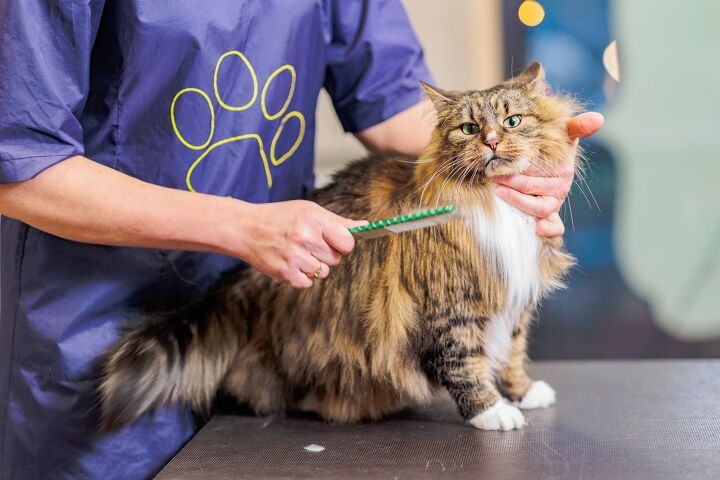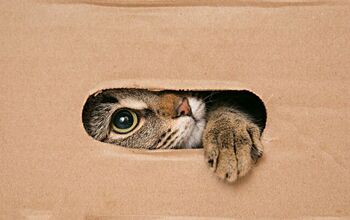How Do I Fix My Cat's Matted Fur?

Tangles and knots can quickly turn a cat’s coat into a chaotic mess. It doesn’t take long before these stubborn snarls leave your cat looking less than stellar – some might even say they resemble a stray! But here’s the real kicker: those unsightly knots can be incredibly painful and even lead to skin infections or other complications.
When the tangles start to add up, it can quickly become overwhelming. Before you realize it, you're dealing with a significant matting issue, and you may have no clue where to begin when it comes to addressing it.
In this article, we will guide you through the process of getting your cat’s fur back to its soft, glossy best. After all, we all want our best friends to look like the incredible beings we know them to be!
What is Matting?
The term “matting” describes when a cat’s fur has become knotted together in clumps. These clumps often begin smaller, but the longer they are left, the larger they can grow and combine. In the most severe cases, large portions of a cat’s coat will be entangled together in one large mat. Smaller mats may be able to be combed out carefully. However, larger mats may require the experienced hand of a professional, or the coat may need to be shaved off.
Why Does Cat Fur Get Matted?
When encountering a matted cat, many people will assume that it is a case of neglect or poor care. But it is safe to say if you are searching for more information about how to help your cat, that isn’t the case! Several possible explanations exist for why mats may form in your cat’s coat. In many cases, cat parents simply don’t understand the grooming needs of their furry friends to keep up with them properly.
A few common reasons why a cat may develop mats in their fur include:
Failure to Keep Up with Self Grooming
Cats are generally good at keeping themselves clean. However, if your cat struggles to self-groom or is no longer taking care of their grooming needs, it can lead to trouble. This could result from aging, obesity, or injuries, making it difficult for your cat to reach their body to groom. It could also be a sign of dental problems or oral injuries.
Areas of Movement
If you have a cat with longer fur, they may be experiencing knots and small mats in areas where their movement increases the rate at which the fur gets tangled. This is commonly seen around the collar (if your cat wears a collar), between the legs, and under the chest.
Shedding Season
During shedding season, your cat is losing more hair than usual, which creates an increased risk that the fur becomes tangled and stuck in the undercoat. Mats can form unnoticed, hidden by the heavy overcoat, allowing them to progress significantly before being discovered.
Medical Causes
Arthritis and obesity aren’t the only medical causes that can contribute to the development of mats. Some conditions, like hyperthyroid disease, cause an increase in body oils. These excess oils cause your cat’s fur to become dirty and start matting faster than they would usually.
Is Matted Fur Painful for Cats?
Yes! If your cat suffers from matted fur, it can become very painful. As the mats become tighter, they can pull on the skin each time they move. In severe mats, it could be pulling the fur out with even a minor movement. If left unaddressed, they can also lead to further complications and health problems.
Potential complications caused by matted fur include:
- Skin irritation and inflammation
- Bacterial or fungal infections
- Pests like fleas, ticks, or even maggots
- Circulation problems/Cutting off blood supply to extremities
- Difficulty regulating body temperature
In the most severe cases, matting can limit your pet’s movement and prevent them from being able to perform normal daily functions like eating, drinking, or using the litterbox.
How Do You Detangle Severely Matted Cat Hair?
Now that we have established why you should be concerned about knots and matting in your cat’s fur let’s look at what you can do to remedy the situation. After all, even cats that are well cared for may run into a problem in some circumstances!
The first and most important thing we can do for our cats is to ensure that we always check for signs of trouble. As I previously mentioned, some mats will hide in the undercoat and continue to worsen while going unnoticed until they have grown into a larger problem. The earlier you identify matting, the easier it will be to address.
If you notice that your cat has developed a mat, you can try untangling it or separating the fur using your fingers or using a comb. But be careful with combing. You want to avoid just pulling on the mat, tugging at the fur and causing unnecessary pain. You can sprinkle a little cornstarch onto the mat, working it in with your fingers to absorb any oils contributing to the mat. Then, slowly comb the ends of the mat to release the fur while holding at the base of the mat with your thumb and forefinger.
There are also specialized de-matting tools that cut through the mat while protecting your cat’s delicate skin.
Contact a professional groomer for cases of severe matting. They are skilled in removing the mats without causing unnecessary pain. Alternatively, if they can’t be removed safely, a groomer can carefully shave your pet down with minimal discomfort.
Should I Remove My Cat’s Matted Fur?
If you discover a small mat or two, you may be tempted to snip them out of your cat’s fur with scissors. Unless you are a trained and experienced groomer, never try to remove mats from your cat’s fur at home. Cats have very thin, delicate skin, and it’s easy to accidentally nick the skin when cutting your cat’s fur.
The one exception is for cat parents who are experienced in using clippers with their cat (and a cat that is comfortable with the use of clippers). For mats that aren’t too close to the skin, the clippers can be used to cut them out.
However, if you have never cut your cat’s fur before or if they have never been exposed to clippers, this isn’t the time to learn. Instead, have the mats addressed by a professional. You can introduce your cat to the clippers when you don’t have to worry about the matting causing pain. This will make it easier to create a positive association with the process.
6 Tips to Prevent Matted Cat Hair
Keep Up with Regular Brushing
The most important thing you can do for your cat is to set a schedule for their grooming and stick to it. This includes daily brushing for long-haired cats or medium-haired cats. Most short-haired cats can go a little longer, with most needing weekly brushing. This will prevent knots from forming, significantly reducing the risk of any issues. Use the best brush for your cat’s fur length, like a wide-tooth comb for longer coats and a simple slicker brush for short coats.
Increase Brushing During Heavy Shedding Seasons
Do you notice your cat sheds more during the spring or fall seasons? If so, you’re not alone! Known as “shedding season,” the changing of season can greatly increase shedding. Heavier shedding means more loose hair that can become tangled and matted. Our long-haired tortie Pippen must be brushed twice daily for a week or two during shedding season to stay on top of it.
Pay Careful Attention to Injured and Aging Cats
Sometimes, in your cat’s life, they need a little extra grooming attention. As we previously mentioned, arthritis, injuries, and obesity can make it difficult for cats to reach and keep up with their own grooming. Physical ailments aren’t the only limitations – senior cats struggling with feline dementia may struggle to remember to groom themselves, increasing their risk of matting.
Do Body Checks
Take time every couple of days to run your hands through your pet’s fur, feeling for any signs of knotting or mats. This can easily be done when you are curled up together on the couch or giving your cat some affection. If you discover any signs of trouble during these checks, you can act quickly before the matting gets worse, leading to further complications.
Vitamin E and Omega-3 Fatty Acids
You can improve your cat’s skin and coat health, helping to reduce the risk of knots and matting, by including vitamin E and Omega-3 fatty acids in their diet. This can be accomplished by selecting a food that contains these beneficial nutrients, adding a food topper to their meals, or incorporating a supplement into their daily routine.
For example, our cats are given Zesty Paws Pure Wild Alaskan Salmon Oil daily on their kibble. They seem to love the taste because they get excited when they see it. Not only does it help with their skin and coat health, but it is also beneficial for their cardiovascular and immune systems.
Make a Standing Grooming Appointment
Do you struggle to keep up with your cat’s grooming needs due to a busy schedule? Does your cat absolutely hate being brushed, making the task feel impossible at the best of times? One guaranteed way to prevent mats in your cat is to make (and stick to) regular grooming appointments with a professional. The frequency of appointments will depend on your cat, their coat length, and the amount of time you can commit to grooming at home. If you’re unsure, contact your groomer to discuss your unique situation. Don’t worry about being judged for needing help – the fact that you are trying to set up a plan to be proactive proves you are a great cat parent!
Final Thoughts – Matting in Cats
Mats can be extremely uncomfortable for your cat, even causing severe health complications. Luckily, there are easy and budget-friendly ways to keep these pesky knots and mats away. Commit to brushing your cat regularly –daily for long or medium fur or weekly for short fur. However, some cats will need a little extra attention. This includes senior cats (due to arthritis or feline dementia), obese cats, or those recovering from injuries that impact their movement or ability to reach to groom in any way.
If you notice matting in your cat’s fur, it must be addressed as soon as possible. Smaller mats can often be broken up or combed out at home without causing too much discomfort. However, if the problem has progressed, the best solution is to contact a professional groomer.
Join the PetGuide community. Get the latest pet news and product recommendations by subscribing to our newsletter here.

Britt Kascjak is a proud pet mom, sharing her heart (and her home) with her “pack” which includes her husband John, their 2 dogs – Indiana and Lucifer – and their 2 cats – Pippen and Jinx. She has been active in the animal rescue community for over 15 years, volunteering, fostering and advocating for organizations across Canada and the US. In her free time, she enjoys traveling around the country camping, hiking, and canoeing with her pets.
More by Britt
























